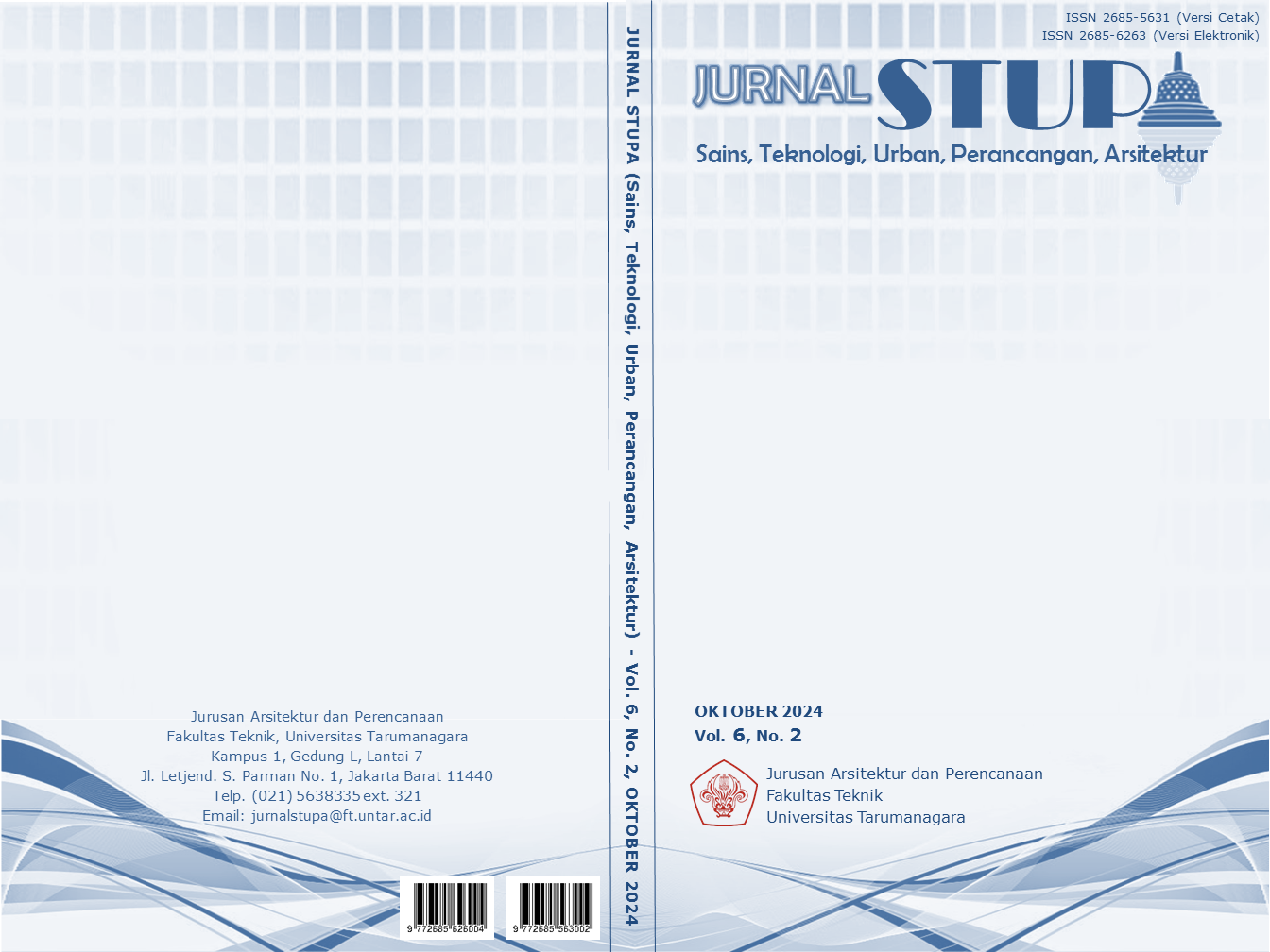MENGHIDUPKAN KEMBALI IDENTITAS KELURAHAN KEBON JERUK MELALUI STRATEGI PLACEMAKING
Main Article Content
Abstract
Identity is an important factor in the meaning of a place. Identity here is formed from the authentic elements of a place that differentiate it from others. However, over time, a place can become placeless due to physical, economic or social degradation, which is known as a placeless place. Kebon Jeruk is one of them that experiences the placeless place phenomenon. It is named Kebon Jeruk because of its identity as the largest citrus fruit producing area since Dutch colonialism. It started with the implementation of a forced planting system policy which in this area focused on growing oranges. Shortly after independence, this area still maintained its identity as an orange plantation. The farmers grew crops in their yards without any coercion from the Dutch and then sold the harvests to the market, and some for their own consumption. This is a symbolic bond between nature and humans living side by side and complementing each other. However, this area has failed to adapt to an era where the identity of the name Kebon Jeruk is now not reflected in an area that is densely populated with residential areas and offices. Therefore, an architectural approach is needed with the aim of restoring the area's identity both in terms of culture and history, which can build a sense of place attachment among residents so that it has a long-term impact. With the programming method, it combines two main programs in the form of urban farming and edutainment into a new program, namely the agrotourism program. It is hoped that it can provide awareness of the importance of preserving the identity of Kebon Jeruk, as oranges have become a flavoring medium to build a sense of place attachment and have one's memory.
Keywords: Edutainment; Kebon Jeruk; Urban Farming; Placeless Place; Placemaking
Abstrak
Identitas menjadi faktor penting akan pemaknaan place dari suatu tempat. Identitas disini terbentuk dari unsur otentik suatu tempat yang membedakannya dengan yang lain. Namun seiring berjalannya waktu, place dapat berubah menjadi placeless dikarenakan degradasi dari segi fisik, ekonomi, atau sosial yang dikenal sebagai placeless place. Kebon Jeruk merupakan salah satunya yang mengalami fenomena placeless place. Dinamakan Kebon Jeruk karena identitasnya sebagai kawasan penghasil buah jeruk terbesar sejak penjajahan Belanda. Berawal dari diberlakukan kebijakan sistem tanam paksa yang pada kawasan ini berfokus menanam jeruk. Sesaat setelah kemerdekaan, kawasan ini tetap mempertahankan identitasnya sebagai perkebunan jeruk. Para petani bercocok tanam di halaman rumahnya tanpa adanya paksaan dari Belanda yang kemudian hasilnya dijual ke pasar, dan sebagian untuk konsumsi sendiri. Hal ini menjadi ikatan simbolis antara alam dan manusia hidup berdampingan saling melengkapi. Akan tetapi, kawasan ini gagal beradaptasi dengan zaman dimana identitas dari nama Kebon Jeruk sekarang tidak tercermin pada kawasan yang padat pemukiman, dan perkantoran. Oleh karena itu, dibutuhkan pendekatan arsitektural dengan tujuan mengembalikan identitas kawasan baik dari segi budaya, dan sejarah terkandung yang dapat membangun rasa place attachment para warga sehingga berdampak secara jangka panjang. Dengan metode disprogramming menggabungkan dua program utama berupa urban farming dan edutainment menjadi suatu program baru, yakni program agrowisata. Diharapkan dapat memberikan kesadaran akan pentingnya melestarikan identitas Kebon Jeruk sebagai jeruk menjadi media perasa untuk membangun rasa place attacment dari memori seseorang.
Article Details

This work is licensed under a Creative Commons Attribution-NonCommercial-ShareAlike 4.0 International License.
This work is licensed under a Jurnal Sains, Teknologi, Urban, Perancangan, Arsitektur/ STUPA Creative Commons Attribution-NonCommercial-ShareAlike 4.0 International LicenseReferences
Anico, M., & Peralta, E. (2008). Heritage and Identity: Engagement and Demission in the Contemporary World. London, United Kingdom: Routledge. doi:9780203886007
Bimantoro, D., Dewiyanti, D., Aditya, N. C., & Natalia, T. W. (2022, Maret). Studi Konsep Pendekatan Placemaking Pada Perancangan Ruang Publik M Bloc Space, Jakarta Selatan. Jurnal Desain dan Arsitektur, 3(1), 22-30. doi:10.34010/desa.v3i1.7862
Counted, V., & Watts, F. (2017). Place Attachment in the Bible: The Role of Attachment to Sacred Places in Religious Life. Journal of Psychology and Theology, 45(3), 218-232. doi:10.1177/009164711704500305
Deviantoro, A. C. (2020, Juni 17). Fasilitas Pelatihan Urban Vertical Agriculture di Kabupaten Buleleng. Yogyakarta: Universitas Atma Jaya Yogyakarta. Dipetik 7 7, 2024, dari http://e-journal.uajy.ac.id/id/eprint/29277
Khalil, H. I., & Wahhab, K. A. (2020). Advantage of Vertical Farming over Horizontal Farming in Achieving Sustainable City, Baghdad City-commercial Street Case Study. IOP Conference Series Materials Science and Engineering: The Fourth Postgraduate Engineering Conference. 745 (2020) 012173, hal. 1-1516. Bagdad: University of Technology. doi:10.1088/1757-899X/745/1/012173
Kusuma, H. (2014, 8 27). beritajakarta.id. (Dunih, Editor) Dipetik 7 7, 2024, dari Kelurahan Kebon Jeruk Gagal Panen Jeruk: https://m.beritajakarta.id/read/4546/kelurahan-kebon-jeruk-gagal-panen-jeruk
Lambrecht, C. (2020, 9 11). Placeless Architecture. Dipetik 7 7, 2024, dari confluence.gallatin.nyu.edu: https://confluence.gallatin.nyu.edu/sections/research/placeless-architecture
Mayona, E. L. (2021, Mei). Pergeseran Makna Kota Berdasarkan Perspektif Lingkungan. RekaLoka: Jurnal Online Institut Teknologi Nasional, 1(1), 1-10. Diambil kembali dari https://ejurnal.itenas.ac.id/index.php/rekaloka/article/view/4793
Mirsa, R., & Yati, Z. F. (2020, Januari). Kajian Sense Of Place Pada Koridor Pasar Tomok Kabupaten Samosir. SENTHONG: Jurnal Ilmiah Mahasiswa Arsitektur, 3(1), 314-323. Diambil kembali dari https://jurnal.ft.uns.ac.id/index.php/senthong/article/view/1135
Ramli, N. A., & Ujang, N. (2020, 4). Adaptation of Social Attributes of Place in Creative Placemaking towards Social Sustainability. Asian Journal of Quality of Life, 5(18), 1-19. doi:10.21834/ajqol.v5i18.202
Relph, E. (1976). Place and Placelessness. London, Brondesbury Park, England: Pion Limited. Dipetik Februari 7, 2024, dari https://kupdf.net/download/edward-relph-place-and-placelessness-1976_5afae515e2b6f5a930bf743c_pdf
Tschumi, B. (1996). Architecture and Disjunction. Massachusetts: The MIT Press. Dipetik 7 10, 2024
Tuan, Y.-F. (1977). Space and Place: The Perspective of Experience. London: University of Minnesota Press.
Young, S., & Kosasih, A. P. (2019). Analisis Sistem Pencahayaan dan Penerapan Green Wall Pada Mall Grand City Surabaya. Seminar Nasional membahas infrastruktur berkelanjutan di era revolusi industri 4.0 (hal. 1-8). Malang: ITN Malang. doi:10.36040/semsina.vi.2211
Zaenuddin, H. (2012). 212 Asal-Usul Djakarta Tempo Doeloe. (M. Zidane, Penyunt.) Jakarta: Ufuk Publishing House. doi:978-602-1097-79-3



